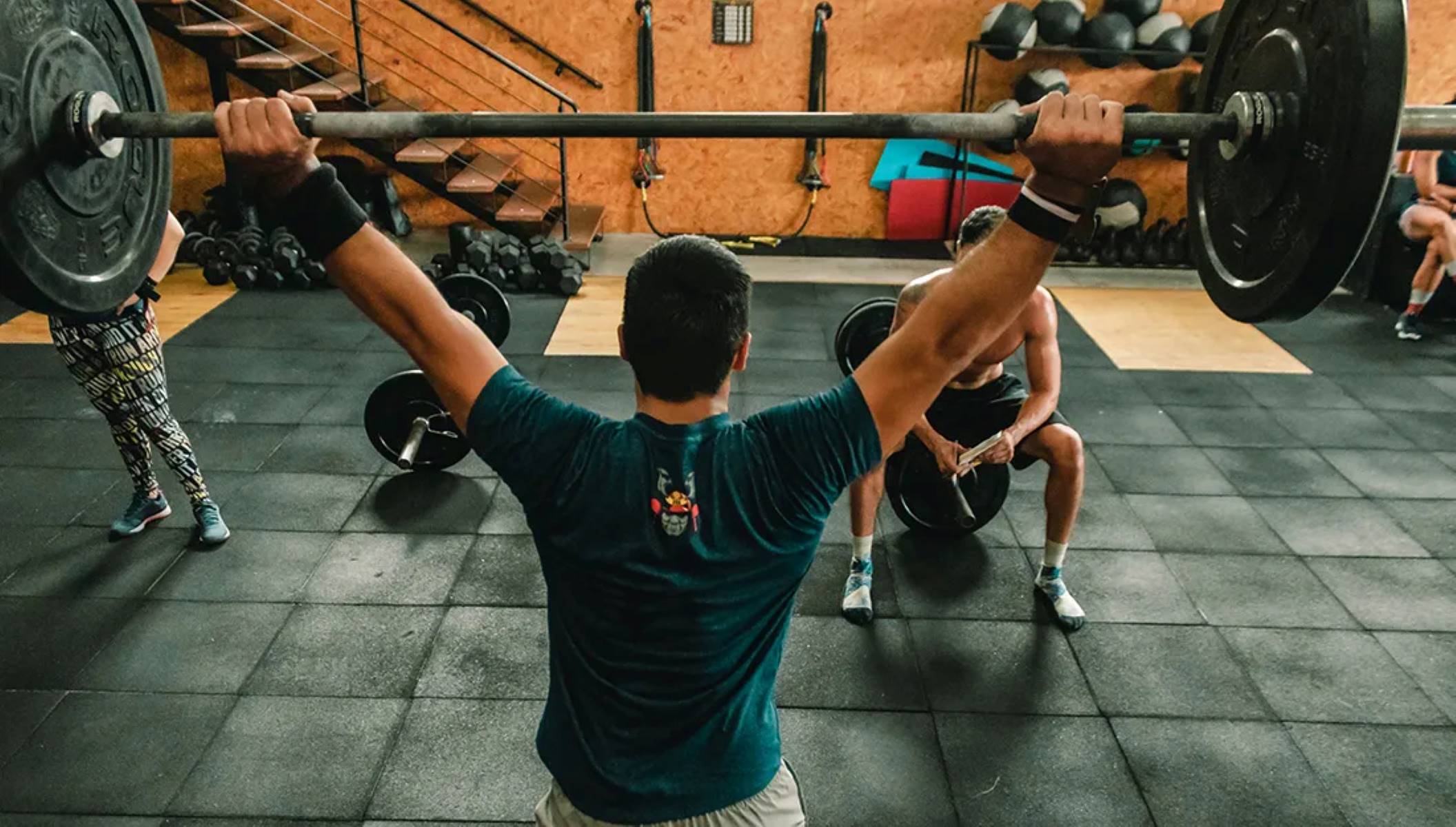

Featured
What Does Muscular Endurance Mean?
Modified: March 2, 2024
Learn the meaning of muscular endurance and why it is crucial for your fitness goals. Discover our featured tips and exercises to improve your endurance today!
Introduction
Muscular endurance is a critical component of physical fitness that often goes hand in hand with muscular strength. While muscular strength refers to the maximum force that a muscle or group of muscles can exert, muscular endurance refers to the ability of those muscles to repeatedly perform a specific action over an extended period of time. It is the measure of how well a muscle can resist fatigue during repetitive contractions. Muscular endurance is important in various activities, such as running, cycling, swimming, weightlifting, and many other sports and exercises.
Having good muscular endurance not only allows us to perform daily activities with ease, but it also plays a significant role in enhancing athletic performance and reducing the risk of injuries. For example, a runner with good muscular endurance can maintain a steady pace throughout a long-distance race, while a weightlifter with strong endurance can perform a higher number of repetitions with the same weight without getting tired.
Muscular endurance is not solely determined by the strength and size of the muscles. It also relies on various other factors, such as the efficiency of the cardiovascular system, the oxygen-carrying capacity of the blood, the muscle fiber type, and the ability to utilize energy sources effectively. Additionally, muscular endurance can be developed and improved through specific training techniques and exercises.
In this article, we will explore the definition and importance of muscular endurance, discuss the benefits of muscular endurance training, examine the factors that affect muscular endurance, provide tips on how to improve muscular endurance, and highlight the differences between muscular endurance and muscular strength. Additionally, we will suggest some common exercises to enhance your muscular endurance and offer precautions to keep in mind during your training.
Definition of Muscular Endurance
Muscular endurance refers to the ability of a muscle or a group of muscles to sustain repeated contractions against resistance or perform a specific action for an extended period of time without experiencing fatigue. It is a measure of how well a muscle can withstand the stress of continuous or prolonged activity.
Muscular endurance is often assessed by measuring the number of repetitions a person can perform with a certain weight or how long they can sustain a particular exercise or movement. For example, a common test of muscular endurance is performing as many push-ups as possible or holding a plank position for as long as possible.
Unlike muscular strength, which is focused on exerting maximum force in a single effort, muscular endurance is about maintaining a level of effort or force over an extended duration. It involves the sustained recruitment and activation of muscle fibers to perform repetitive movements or tasks.
There are two main types of muscular endurance:
- Localized Muscular Endurance: This refers to the endurance of a specific muscle or muscle group. It is targeted towards the ability of a particular muscle or group to resist fatigue and maintain strength and function over time. For example, performing multiple sets of bicep curls to exhaust the biceps muscles.
- General Muscular Endurance: This encompasses the overall muscular endurance of the whole body. It involves the ability to perform activities that require multiple muscle groups working together for an extended period of time, such as running a marathon or participating in a high-intensity interval training (HIIT) session.
It is important to note that muscular endurance is specific to the type of activity or exercise being performed. For instance, someone with great endurance in running may not necessarily have the same level of endurance in weightlifting or vice versa.
Overall, muscular endurance plays a crucial role in various aspects of physical performance and day-to-day activities. It allows individuals to maintain strength, power, and control while enduring prolonged exertion, leading to improved athletic performance and increased resistance to fatigue.
Importance of Muscular Endurance
Muscular endurance is an essential component of physical fitness that holds significant importance in various aspects of our lives. Whether you are an athlete, a fitness enthusiast, or someone simply looking to improve your overall health, developing and maintaining muscular endurance can bring about several benefits.
1. Enhanced Performance: Muscular endurance is crucial for individuals involved in activities that require repetitive movements or sustained efforts over a prolonged period. Endurance athletes, such as long-distance runners or cyclists, rely heavily on muscular endurance to maintain a consistent pace throughout their races. Similarly, team sports like soccer or basketball demand the ability to perform repeated bursts of activity without experiencing exhaustion.
2. Reduced Fatigue: Building muscular endurance helps delay the onset of muscle fatigue. When the muscles are trained to endure prolonged contractions, they become more efficient in utilizing energy sources and can continue performing at a high level for an extended duration. This can be immensely beneficial in everyday tasks that require physical exertion, such as moving furniture, gardening, or even carrying groceries up the stairs.
3. Injury Prevention: Muscular endurance plays a vital role in injury prevention. When muscles are fatigue-resistant, they can provide better support and stability to the joints, reducing the risk of injuries. Strong and enduring muscles help maintain proper body mechanics and form during physical activities, minimizing the chances of accidents or strains.
4. Improved Metabolic Health: Muscular endurance training increases the metabolic demand on the body, leading to improvements in cardiovascular health and overall metabolism. By engaging in activities that require sustained muscle contractions, the heart and lungs are challenged to deliver oxygen and nutrients to the muscles efficiently. This promotes a stronger cardiovascular system and enhances the body’s ability to burn calories and fat.
5. Enhanced Daily Functionality: Having good muscular endurance directly translates to improved functional capacity in daily life activities. Tasks like carrying heavy bags, climbing stairs, or even standing for an extended period become easier when your muscles can endure the demands of the activity without fatigue. Increased muscular endurance can lead to better posture, balance, and overall physical resilience, contributing to a higher quality of life.
Overall, developing muscular endurance is vital for individuals of all fitness levels. It not only enhances athletic performance but also improves overall health, reduces the risk of injuries, and promotes an active and functional lifestyle. Incorporating exercises and training methods that target muscular endurance into your fitness routine is a surefire way to reap these benefits.
Benefits of Muscular Endurance Training
Muscular endurance training, which involves exercises aimed at improving the ability of muscles to sustain repeated contractions over time, offers a wide range of benefits that go beyond just physical fitness. Whether you are an athlete looking to enhance your performance or an individual striving for better overall health, incorporating muscular endurance training into your routine can bring about significant advantages.
1. Increased Stamina: Muscular endurance training improves your stamina by increasing the capacity of your muscles to perform sustained activities. This allows you to engage in physical tasks for longer periods without experiencing fatigue. Whether it’s running, cycling, or participating in a high-intensity workout, improved stamina enables you to push through the challenges and maintain optimal performance.
2. Improved Muscle Tone: Engaging in muscular endurance exercises helps to sculpt and define your muscles. As you train your muscles to endure repetitive contractions, they become leaner and gain better definition. This leads to improved muscle tone, giving you a more sculpted and aesthetically pleasing physique.
3. Enhanced Metabolic Rate: Muscular endurance training increases the metabolic demands on your body. This means that your body will continue to burn calories even after you’ve completed your workout. By building and maintaining lean muscle mass, you can boost your metabolism, leading to improved weight management and fat loss.
4. Reduced Risk of Injuries: Muscular endurance exercises help strengthen the muscles and the connective tissues surrounding your joints. This provides better support and stability, reducing the risk of injuries during physical activities. Stronger muscles not only protect your joints but also help maintain proper form and alignment, minimizing the chances of strains and sprains.
5. Improved Mental Stamina: Muscular endurance training not only benefits your physical fitness but also has positive effects on your mental stamina. Pushing through challenging workouts and overcoming the urge to stop builds mental resilience and enhances your ability to persist through difficult situations. This can extend beyond your workouts, helping you face challenges in other aspects of your life with a greater sense of determination and perseverance.
6. Enhanced Aerobic Capacity: Muscular endurance training often involves aerobic exercises that increase your heart rate and improve cardiovascular fitness. By engaging in activities that target both muscular and cardiovascular endurance, you can enhance your aerobic capacity. This means that your body becomes more efficient at delivering oxygen to your muscles, allowing you to perform at higher intensities for longer durations.
7. Improved Overall Physical Performance: Muscular endurance training has a positive impact on various aspects of physical performance. Whether it’s running, cycling, swimming, or participating in sports, having greater muscular endurance enables you to perform at a higher level for longer durations. You’ll experience enhanced strength, power, and endurance, leading to improved performance in your chosen activities.
Incorporating muscular endurance training into your fitness routine can provide numerous benefits that extend beyond just physical fitness. Improved stamina, muscle tone, metabolic rate, and mental stamina are just a few of the advantages you can expect. Additionally, reduced risk of injuries and enhanced physical performance make muscular endurance training a valuable component of any well-rounded exercise program.
Factors Affecting Muscular Endurance
Muscular endurance, like any other aspect of fitness, is influenced by various factors that can impact an individual’s ability to sustain repetitive muscular contractions over time. Understanding these factors can help you tailor your training and optimize your muscular endurance gains. Here are some key factors that affect muscular endurance:
1. Muscle Fiber Type: The composition of muscle fibers in your body plays a significant role in determining your muscular endurance. There are two main types of muscle fibers: slow-twitch (Type I) and fast-twitch (Type II) fibers. Slow-twitch fibers have a higher ability to resist fatigue and are more efficient in endurance-based activities. Fast-twitch fibers, on the other hand, are more geared towards explosive movements but fatigue more quickly. Genetic factors determine the ratio of these muscle fiber types in your body, influencing your inherent muscular endurance potential.
2. Cardiovascular System: A strong and efficient cardiovascular system is crucial for optimal muscular endurance. This system is responsible for delivering oxygen-rich blood to the muscles, removing waste products, and providing the necessary nutrients for energy production. A well-developed cardiovascular system ensures that the muscles receive an adequate supply of oxygen and nutrients during prolonged activities, delaying the onset of fatigue and improving muscular endurance.
3. Muscle Strength: While muscular strength and muscular endurance are distinctly different, they are interconnected. Having a certain level of muscular strength is essential for performing various exercises and activities that challenge muscular endurance. Strengthening the muscles involved in a particular movement or exercise can enhance your ability to sustain that activity over time. Therefore, developing adequate muscular strength is a critical component of improving muscular endurance.
4. Energy Utilization: Efficient energy utilization is crucial for sustaining muscular endurance. The body primarily relies on two main energy systems during exercise: the aerobic system and the anaerobic system. The aerobic system utilizes oxygen to produce energy and is predominant in activities lasting longer than a couple of minutes. The anaerobic system relies on stored energy in the muscles and provides quick bursts of energy for short-duration, high-intensity activities. Training these energy systems appropriately can improve overall energy utilization and increase muscular endurance.
5. Training Volume and Intensity: The volume (number of sets, repetitions, or duration) and intensity (relative load or effort) of your training play a significant role in developing muscular endurance. Training with moderate to high volume and focusing on repetitions rather than heavy weights can improve the endurance capacity of your muscles. Gradually increasing the workload over time, incorporating progressive overload principles, allows your muscles to adapt and become more fatigue-resistant.
6. Rest and Recovery: Adequate rest and recovery are crucial for muscular endurance gains. Giving your muscles enough time to recover between training sessions allows them to repair and rebuild, leading to muscle adaptation and improved endurance. Overtraining or not allowing for sufficient recovery can lead to fatigue, decreased performance, and increased risk of injury.
It is important to note that these factors are interconnected and can vary from person to person. Genetics, training history, nutrition, and other individual factors also influence muscular endurance. By understanding and addressing these factors through proper training techniques, adequate nutrition, and recovery strategies, you can optimize your muscular endurance and achieve your fitness goals.
How to Improve Muscular Endurance
Improving muscular endurance requires consistent effort and a targeted approach to training. By following these strategies, you can effectively enhance your muscular endurance and maximize your physical performance:
1. Incorporate Endurance Training: Engage in activities that target muscular endurance, such as circuit training, high-repetition strength training, or aerobic exercises like running, swimming, or cycling. These types of exercises challenge your muscles to sustain contractions over an extended period, improving their endurance capacity.
2. Use Lighter Weights and Higher Repetitions: Modify your strength training workouts by using lighter weights and performing higher repetitions. This approach focuses on muscular endurance rather than building pure strength. Aim for 12-20 repetitions per set with a weight that challenges you towards the end of each set.
3. Reduce Rest Periods: Shorten your rest periods between sets or exercises to keep the muscles engaged for a longer duration. By decreasing the rest time, you can increase the metabolic demand on the muscles, promoting improved endurance.
4. Incorporate Circuit Training: Circuit training involves performing a series of exercises back-to-back, targeting different muscle groups. This form of training combines strength and cardiovascular exercises, challenging your muscles to endure sustained effort. Design your circuit with a mix of compound exercises targeting major muscle groups for maximum efficiency.
5. Progressive Overload: Gradually increase the intensity, duration, or volume of your workouts to provide a progressive challenge to your muscles. This method encourages adaptation and helps improve muscular endurance over time. Add more repetitions, increase the resistance, or extend the duration of your exercises as you progress.
6. Mix Up Training Modalities: Incorporate different training modalities and exercise variations to avoid plateau and keep your muscles challenged. Add variety to your workouts by utilizing different equipment, workout styles, or training environments. This not only prevents boredom but also provides a well-rounded approach to developing muscular endurance.
7. Focus on Proper Form: Maintaining proper form during exercises is essential for targeting the intended muscles and avoiding injuries. Ensure that you are executing each exercise with correct technique, engaging the appropriate muscles, and maintaining proper alignment. This ensures that your muscles are effectively trained for endurance and minimizes the risk of imbalances or strain.
8. Ensure Sufficient Recovery: Allow your muscles enough time to recover between workout sessions to promote proper muscle repair and growth. Muscular endurance gains are achieved during the recovery phase, so prioritize adequate rest, sleep, and nutrition to support your training efforts. Aim for at least one to two days of rest per week to optimize recovery.
Improving muscular endurance requires consistency, patience, and a well-rounded training approach. By incorporating targeted exercises, progressively challenging your muscles, and allowing for adequate recovery, you can enhance your muscular endurance and unlock your full athletic potential.
Muscular Endurance versus Muscular Strength
Muscular endurance and muscular strength are closely related yet distinct components of physical fitness. While both involve the muscles, they focus on different aspects of muscle performance. Understanding the differences between muscular endurance and muscular strength can help you design a well-rounded training program that caters to your specific goals.
Muscular Endurance: Muscular endurance refers to the ability of a muscle or group of muscles to sustain repeated contractions over an extended period of time. It is a measure of how well a muscle can resist fatigue during continuous or prolonged activity. Muscular endurance exercises typically involve moderate to low levels of resistance with high repetitions. Endurance-focused workouts are geared towards improving cardiovascular fitness, enhancing stamina, and increasing the muscle’s ability to perform repetitive movements over time. Activities such as long-distance running, cycling, or participating in high-intensity interval training (HIIT) routines are perfect examples of exercises that target muscular endurance.
Muscular Strength: On the other hand, muscular strength refers to the maximal force a muscle or group of muscles can exert against a resistance in a single all-out effort. It measures the muscle’s ability to generate power during short-duration, high-intensity activities. Muscular strength exercises typically involve high levels of resistance with lower repetitions. Building muscular strength involves pushing your muscles to their maximum capacity, with exercises such as heavy weightlifting, powerlifting, or performing explosive movements like Olympic lifts. Strength-focused training helps increase the size and strength of the muscle fibers, leading to greater power production and improved performance in activities requiring quick bursts of force.
While muscular endurance and muscular strength may seem like opposing concepts, they are not mutually exclusive. Many training programs incorporate elements of both in order to optimize overall fitness. For example, athletes participating in sports like basketball or soccer require a combination of muscular endurance for continuous running and muscular strength for explosive movements and physical contact.
It’s important to identify your specific goals when designing a training program. If you’re looking to improve athletic performance or excel in endurance activities, prioritizing muscular endurance training is key. Conversely, if your goal is to build raw strength and power, focusing on muscular strength exercises is essential. However, incorporating elements of both types of training can lead to a well-rounded fitness level and improved overall performance in various activities.
Remember, the specific adaptations and benefits of each type of training can vary, so tailoring your workouts to suit your goals is crucial. Consult with a fitness professional to design a training program that best aligns with your objectives and optimizes both muscular endurance and muscular strength.
Common Exercises to Improve Muscular Endurance
Improving muscular endurance involves engaging in exercises that challenge your muscles to sustain repetitive contractions over an extended period. By incorporating these common endurance-focused exercises into your training routine, you can effectively enhance your muscular endurance:
1. Bodyweight Exercises: Exercises utilizing your bodyweight, such as push-ups, squats, lunges, and planks, are excellent options for building muscular endurance. They can be easily modified to increase or decrease intensity according to your fitness level.
2. High-Intensity Interval Training (HIIT): HIIT workouts involve alternating between periods of high-intensity exercises and periods of active recovery. This type of training challenges both your cardiovascular endurance and muscular endurance simultaneously. Incorporate exercises like burpees, mountain climbers, jump squats, and bicycle crunches into your HIIT routine.
3. Circuit Training: Circuit training involves performing a series of exercises targeting different muscle groups with minimal rest in between. This keeps your heart rate elevated and challenges your muscles to sustain contraction over time. Combine exercises like push-ups, lunges, kettlebell swings, and step-ups in a circuit format to improve muscular endurance.
4. Cardiovascular Activities: Engaging in aerobic exercises such as running, cycling, swimming, or rowing can significantly enhance your muscular endurance. These activities require sustained muscular effort for extended periods, which helps develop the endurance capacity of your muscles and cardiovascular system.
5. Resistance Training with Moderate Weights: Utilize moderate weights and perform higher repetitions to target muscular endurance. Barbell or dumbbell exercises like bicep curls, tricep dips, lateral raises, and shoulder presses can be incorporated into your workout routine to improve muscular endurance.
6. Pilates and Yoga: These mind-body exercises focus on improving muscular endurance through controlled and precise movements. They target multiple muscle groups, helping to build strength while also enhancing flexibility and overall body awareness.
Remember, it is essential to maintain proper form and technique during these exercises to prevent injuries and ensure optimal muscle engagement. Progress your workouts gradually by increasing repetitions, duration, or intensity to continue challenging your muscles and progressively improve your muscular endurance.
Incorporating a variety of endurance-focused exercises into your training routine ensures that different muscle groups are targeted and challenges your body in different ways. Design a well-rounded program that includes a combination of bodyweight exercises, cardio activities, circuit training, and resistance training to enhance your overall muscular endurance.
Precautions and Tips for Training Muscular Endurance
While training to improve muscular endurance is highly beneficial, it’s important to approach it with caution and take certain precautions to ensure safety and optimize your results. Here are some essential precautions and tips to keep in mind when training for muscular endurance:
1. Gradually Increase Intensity and Volume: Progressively increase the intensity and volume of your workouts to avoid overexertion and reduce the risk of injury. Too rapid of an increase can lead to overuse injuries or burnout. Gradually increase weights, repetitions, or duration over time to allow your body to adapt and prevent overtraining.
2. Warm-Up and Cool Down: Prioritize a proper warm-up and cool-down routine before and after your workouts. A thorough warm-up prepares your muscles for the upcoming demands, increases blood flow, and reduces the risk of injury. Cooling down with gentle stretches helps your muscles recover and prevents stiffness.
3. Listen to Your Body: Pay attention to any signs of discomfort, pain, or excessive fatigue during your training sessions. Pushing through pain can lead to injuries. Rest when needed and modify exercises or reduce intensity if necessary. Your body knows its limits, so be mindful and respect its signals.
4. Breathe Properly: Focus on maintaining proper breathing during your exercises. Breathing provides oxygen to your muscles, allowing them to perform efficiently. Inhale during the less demanding portion of the exercise and exhale during the more challenging phase.
5. Maintain Proper Form: Practice proper form and technique with each exercise to ensure muscle engagement, prevent injuries, and optimize results. Poor form can lead to imbalances, strain, and decreased effectiveness of the exercise. If you’re unsure about the correct form, consult a fitness professional for guidance.
6. Hydrate and Fuel Properly: Stay hydrated before, during, and after your workouts. Muscular endurance training can be demanding on your body, and proper hydration supports optimal performance and aids in recovery. Additionally, fuel your body with a balanced diet that includes adequate protein, carbohydrates, and healthy fats to support muscle repair and growth.
7. Rest and Recovery: Allow your body sufficient time to rest and recover between training sessions. This is crucial for optimal muscular endurance gains. Overtraining can lead to fatigue, decreased performance, and increased risk of injury. Aim for at least one to two days of rest per week and prioritize quality sleep to support muscle recovery and growth.
8. Seek Professional Guidance: If you’re new to fitness or unsure about designing an effective training program, seek guidance from a qualified fitness professional. They can assess your individual needs, provide expert guidance on exercise selection and progression, correct your form, and help you avoid injuries.
Remember, the key to improving muscular endurance is consistency, proper technique, and gradual progression. By following these precautions and tips, you can safely and effectively improve your muscular endurance, optimize your performance, and reduce the risk of injuries along the way.
Conclusion
Muscular endurance is a vital aspect of physical fitness that plays a significant role in various activities and sports. It refers to the ability of muscles to sustain repeated contractions over an extended period without experiencing fatigue. By improving muscular endurance, you can enhance your performance, reduce the risk of injuries, and improve your overall well-being.
In this article, we explored the definition of muscular endurance and its importance in various aspects of life. We discussed the benefits of muscular endurance training, which include increased stamina, reduced fatigue, improved metabolic health, and enhanced daily functionality. We also highlighted the factors that influence muscular endurance, such as muscle fiber type, cardiovascular system efficiency, and energy utilization.
To improve muscular endurance, we provided various strategies and tips, including incorporating endurance training, using lighter weights with higher repetitions, reducing rest periods, and incorporating circuit training and cardiovascular activities. We also emphasized the importance of proper form, gradual progression, and sufficient rest and recovery.
Differentiating muscular endurance from muscular strength was also addressed, as both play unique roles in physical performance. We highlighted how muscular endurance focuses on sustaining repetitive contractions over time, while muscular strength involves exerting maximal force in a single effort. Balancing both aspects in training can lead to optimal performance in different activities.
Lastly, we discussed common exercises to improve muscular endurance, such as bodyweight exercises, high-intensity interval training (HIIT), circuit training, cardiovascular activities, resistance training with moderate weights, and Pilates or yoga. These exercises target different muscle groups and promote endurance capacity.
With the precautions and tips provided, we emphasized the importance of taking care of your body during muscular endurance training. Gradual progression, proper warm-up and cool-down routines, listening to your body, maintaining proper form, staying hydrated, getting adequate rest, and seeking professional guidance are crucial for safe and effective training.
Incorporating muscular endurance training into your fitness routine can have a profound impact on your overall health and performance. By focusing on developing your muscular endurance, you can enhance your stamina, reduce fatigue, build lean muscle, and improve your ability to perform everyday activities and athletic pursuits.
So, start implementing these strategies, prioritizing your safety and well-being, and enjoy the benefits of improved muscular endurance for a stronger, fitter, and more resilient you.









